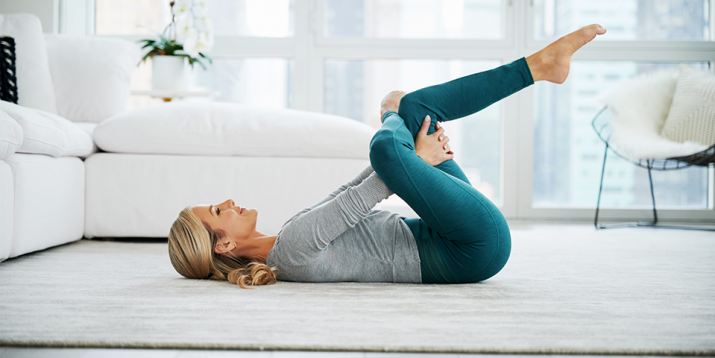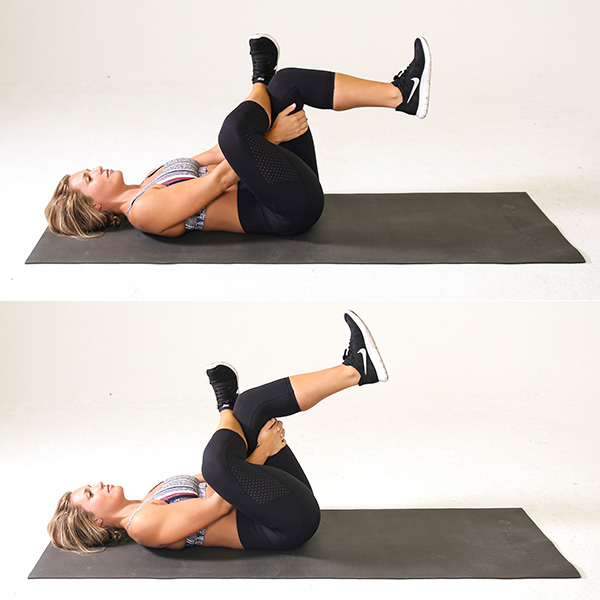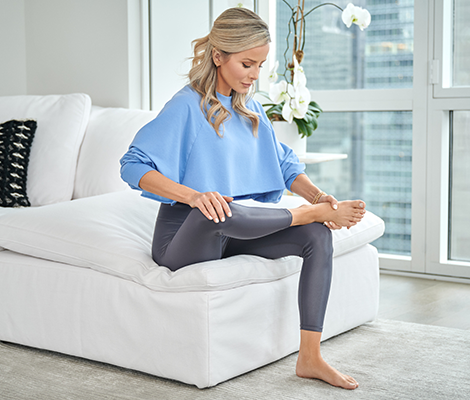How to Do a Figure 4 Stretch

Tight hips can be a real pain in the behind, but the figure 4 stretch can improve flexibility and mobility in your hips, glutes, and piriformis—a small muscle that can become inflamed when your hips are tight.
This hip stretch can be helpful any time you feel sore and tight. Ideally, the figure 4 stretch should be performed after a dynamic warm-up or during a post-workout stretch, says Tom Biggart, a physical therapist and strength coach in the greater Boston area.
Here’s how to perform the figure 4 stretch — and how to work it in your routine.
How to Do the Figure 4 Stretch

- Lie on your back with your feet flat on the floor.
- Cross your right ankle over your left knee and keep your right foot flexed.
- Bring your left knee toward your chest. Reach your right hand through your legs and interlace your fingers just below the crease of your left knee.
- Using your arms, pull your left knee toward your chest, pausing when you feel a stretch in your right glute and hip.
- Hold there for at least five breaths (though you can hold the stretch for up to two minutes) then release and repeat on your left side.
Want to change the intensity of the figure 4 stretch? One of the easiest ways is to change the angle at which you bend the knee on the leg you’re stretching.
“More knee bend will increase the stretch, and less knee bend will decrease the stretch,” Biggart says.
You can also interlace your fingers in front of your shin instead of behind the knee for a deeper stretch.
How Does the Figure 4 Stretch Help?
Sure, it feels good, but what is the figure 4 stretch actually doing for you? The figure 4 stretch can help keep your hips and glutes healthy and mobile.
There are six different muscles that are stretched when performing it, Biggart says — the piriformis, gemellus superior, obturator internus, gemellus inferior, obturator externus, and quadratus femoris.
This group of muscles helps to rotate the thigh outward at the hip joint. “One stretch plus six muscles equals warm and fuzzy feelings,” Biggart adds.
In particular, the stretch you feel deep in your glutes is a muscle called the piriformis, which runs from the base of the spine to the top of the femur and helps with hip rotation and stability.
Because of its close proximity to the sciatic nerve, problems with the piriformis muscle (like swelling, tightening, or muscle spasms) can irritate the sciatic nerve and cause pain and discomfort in the hip and buttocks — a painful condition called piriformis syndrome.
“Keeping the piriformis mobile can reduce irritation or compression of the sciatic nerve,” Biggart says.
Figure 4 Stretch Variations
Want to get even more out of the figure 4 stretch? Try one of these variations.
Seated Figure 4 Stretch

- Sit on the floor with your knees bent and feet flat on the floor.
- Place your hands on the floor slightly behind your hips, to help you stay balanced.
- Cross your right ankle over your left knee and keep your right foot flexed.
- Keeping your lower back in its natural arch, press your hands into the floor and lean your chest toward your knees, stopping when your right glute and hip start to feel a stretch.
- Hold for at least five breaths, then release the stretch and repeat on the opposite side.
Figure 4 Pose at the Wall
- Lie on your back near a wall, with your legs up the wall.
- Bend your knees so your feet are flat against the wall.
- Cross your right ankle over your left knee and keep your right foot flexed. Press your left foot firmly into the wall. Interlace your hands behind your left knee, or let them rest on the floor beside you.
- Keeping your sacrum (the bony area on the back of your pelvis) on the floor, slowly move your left foot down the wall. As you do, your left knee should naturally move toward your chest. Pause when you feel a stretch in your hips and glutes.
- Hold for at least five breaths (or work up to two minutes per side). Release the stretch and repeat on your left side.
(Looking for even more variety? This list of glute stretches includes two more figure 4 stretch variations!)
